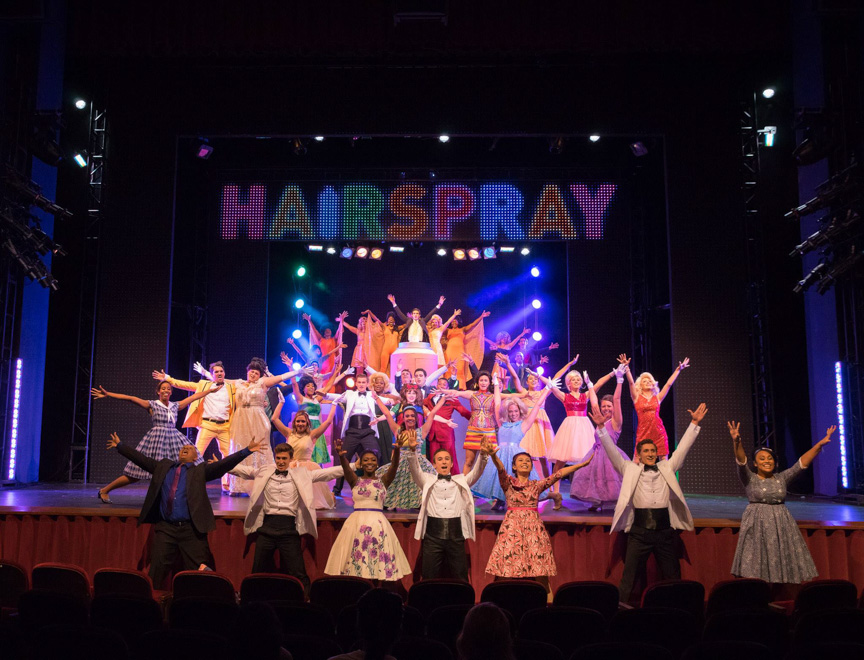In the back of Memorial Auditorium, storage spaces house multiple panels from an LED video wall. When separate, these plywood sections look unimposing, but when fully constructed the LED wall is 20 feet by 40 feet and consists of 20,000 LED lights, meticulously color-corrected for accuracy.
The wall made its debut at Ram’s Head’s 2015 performance of “Hairspray” and has since appeared at events such as Full Moon on the Quad and Dance Marathon. Most astonishingly, the structure was student-created — at about a tenth of the price of commercial equivalents.
The student organization Lighting Innovation and Technology Education at Stanford (LITES) spearheaded the efforts to make the wall. Founded four years ago by Matt Lathrop ’16 and James Sherwood ’17, LITES initially aimed to support lighting designers on campus. According to club president Stephen Hitchcock ’18, LITES soon morphed into a research-driven institution.
“We continue our original mission of supporting lighting designers on campus, providing them with training and financial resources, as well as taking this next step of where lighting is going in the future,” Hitchcock said.
Research
LITES works with various theater organizations on campus but most often partners with Ram’s Head Theatrical Society.
Professor Emeritus of Lighting Design Michael Ramsaur, who advises the club, explained, “The Ram’s Head shows have provided a playground for them to develop their ideas and equipment, whereas the majority of shows the department does are smaller.”
Ram’s Head’s vibrant production of Hairspray, for instance, drove the creation of the LED video wall.
LITES’ first foray into research grew out of Ram’s Head’s production of “Les Miserables.” Lathrop created a system referred to as automated follow spots, which remotely manipulated lighting fixtures to follow actors. Hitchcock joined LITES during its second major project, creating an inexpensive and accurate LED video wall. Last year, LITES used remote follow spots in conjunction with automation to create integrated lighting and motion systems for “Rent.” LITES has published papers on these research projects and presented at international conferences.
Ramsaur, whose 40-year career spans teaching, research and professional lighting design, highlighted that the technology LITES has developed aligns with the research currently being done by the lighting industry.
“What’s interesting is that LITES didn’t become aware of those ideas because of things that other people were doing and decide to work on that,” Ramsaur said. “In approaching the shows they wanted to do in the ways they wanted to do them, they had the same unique ideas.”
Structure
Other than an executive board, membership is fluid — Hitchcock estimates that a core group of 10 people are actively involved, but closer to 30 or 40 students have participated in some form.
According to member Justin Ruggiero ’19, who served as assistant lighting designer for “Rent,” “[The club is] definitely based around the projects that are going on. In a way, it’s an extension of other theater groups on campus.”
In addition to its own research, LITES secures finances for other theater-affiliated projects, often through grants. LITES has also hosted events with speakers, including Broadway lighting designer Dawn Chiang.
As many of its core members move closer to graduation, LITES is turning its focus towards making the club sustainable long-term. LITES vice president Zachary Dammann ’18 noted that he, fellow vice president Michael Tucker and Hitchcock have been involved in LITES since freshman year. Now, it is time to prioritize new members.
“We need to show them the ropes. We need to teach them how the system works, how to run the software. Also, [we are] continuously working to make the software easily accessible, easily available and easy to operate,” Dammann said.
LITES draws on both the technical and artistic interests of its members, bridging Stanford’s commonly cited “techie-fuzzie” divide. Members tend to be involved in theater but also integrate other aspects of their Stanford education, such as mechanical engineering and computer science.
“The thing that tends to really excite people is that it’s the intersection of art and technology. It’s something that as a society we’re seeing more and more, combining those skill sets and those things that were previously separate — that’s really exciting potential,” Hitchcock said.
Contact Claudia Heymach at cheymach ‘at’ stanford.edu.
